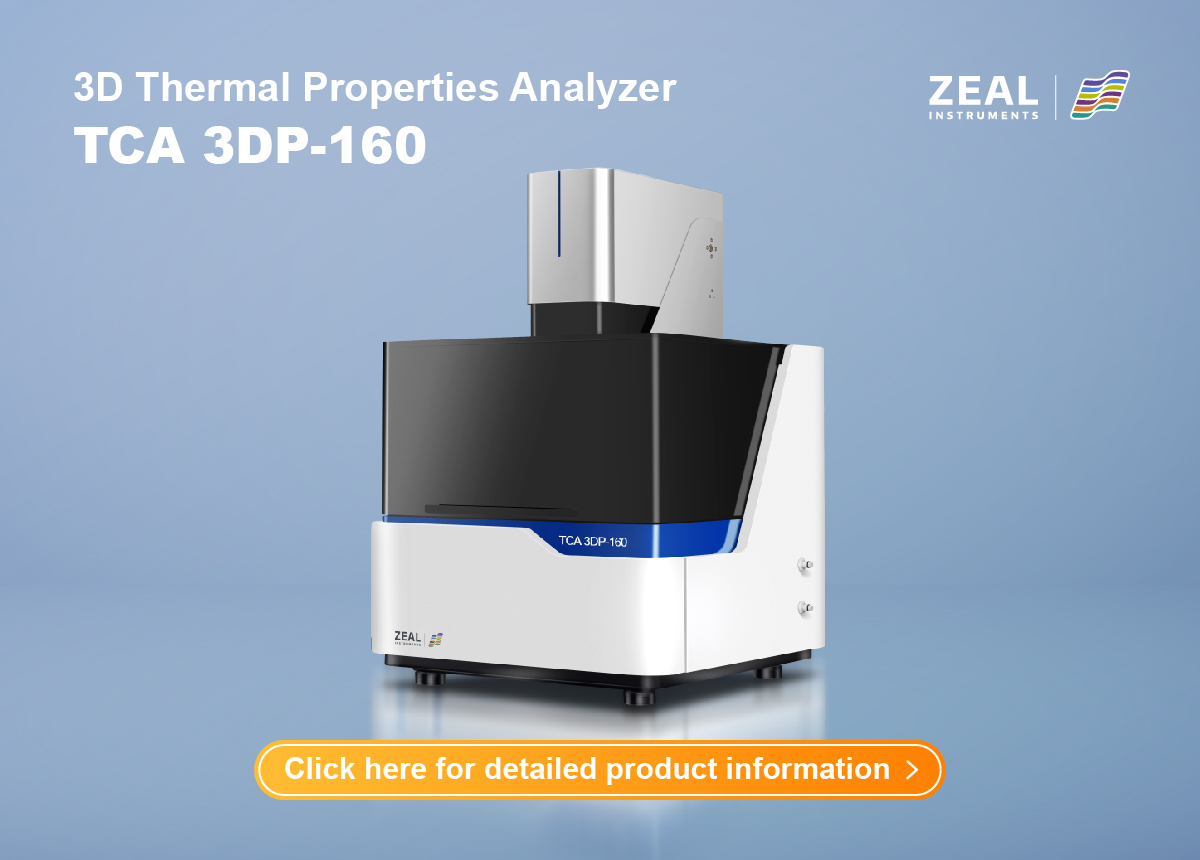Advanced Thermal Analysis Instrument: 3D Thermal Properties Analyzer
Have you ever wondered how crucial thermal analysis is in material science? Accurate thermal properties are vital for designing and optimizing materials, from metals to polymers. Traditional methods, like Differential Scanning Calorimetry (DSC) and Thermogravimetric Analysis (TGA), provide valuable insights but often fall short with complex samples. Enter the 3D Thermal Properties Analyzer, a groundbreaking advancement. The TCA 3DP-160, leveraging non-contact thermography and dynamic 3D data inversion, excels in evaluating thermal conductivity and diffusivity in multi-layered, heterogeneous, and anisotropic materials, such as lithium batteries. This innovation marks a significant leap forward in material characterization, offering precision and versatility previously unattainable.
3D Thermal Properties Analyzer
The 3D Thermal Properties Analyzer is suitable for homogeneous or heterogeneous samples of various specifications, surface hardness, roughness, and porosity. With uniform temperature across six-sided cold plates, high-precision oil bath temperature control, and adjustable ambient temperature, the instrument ensures consistent and accurate measurements. Non-contact measurement with automatic compensation for surface and support heat dissipation interferences further enhances result accuracy. The instrument operation is simple, with fully automated experiment initiation and execution. Automatic generation and saving of graphs and process data, along with support for historical data query, streamline the analysis process.
Technological Innovations Employed in the Instrument
The instrument employs cutting-edge technologies such as non-contact thermography and dynamic 3D data inversion. These innovations facilitate non-destructive testing and allow for accurate measurement of thermal properties in multi-layered, heterogeneous, and anisotropic materials. The integration of advanced temperature control mechanisms and automatic compensation for heat dissipation interferences ensures the reliability of the results.
Features that Differentiate the 3D Thermal Properties Analyzer
The 3D Thermal Properties Analyzer stands out due to its three-dimensional mapping capabilities, which allow for a detailed analysis of thermal properties across different dimensions of the sample. Enhanced sensitivity and accuracy ensure precise measurements, even for complex structured samples. Real-time data processing and visualization enable immediate assessment and decision-making based on the thermal properties of the materials being analyzed.
Testing Principles and Instrument Advantages
Testing Principles
The testing method involves applying a pulse stimulus to the bottom of a lithium battery using a flexible electric heating pad. A non-contact infrared thermal camera is employed to measure the temperature on one side of the battery. The thermal conductivity of the sample, both longitudinally and face-on, is then calculated through data inversion.
- Rectangular Electric Heating Pad Pulse Excitation: The heating pad is centrally adhered to the surface of the sample. Localized heating is applied via pulses, creating longitudinal and face-on heat transfer.
- Non-contact Temperature Measurement with Infrared Thermal Camera: This step involves capturing the two-dimensional spatial distribution and one-dimensional temporal evolution of the observed surface temperature.
- Three-Dimensional Heat Transfer Model Inversion Analysis: The system automatically constructs a three-dimensional heat transfer model using basic sample dimensions and corrects for interference factors such as surface cooling and support cooling. The final result includes test data, predicted data, error data, and error evaluation through inversion calculations.
Instrument Advantages
- Compatibility with Various Samples: The instrument does not require sample destruction and is compatible with samples of different specifications, surface hardness, roughness, and porosity, whether homogeneous or heterogeneous. The maximum sample size it can accommodate is 400250mm x 20mm.
- Precise Temperature Control Design: It features high-precision oil bath temperature control with uniformly cooled six-sided plates. The sample chamber supports temperature control from 0 to 60°C, allowing accurate measurement of the sample’s thermal properties at various temperatures.
- Automatic and Convenient Operation: The experiment is fully automated, with real-time monitoring of process data. It supports historical record queries, date filtering, and custom data export options.
Performance and Validation
Summary of Performance Metrics
The 3D Thermal Properties Analyzer boasts impressive performance metrics.
It covers a broad thermal conductivity range: longitudinal (0.2W/(m-K) to 5W/(m-K)) and transverse (5W/(m-K) to 100W/(m-K)). Its thermal diffusivity range is equally extensive: longitudinal (0.1 mm²/s to 2 mm²/s) and transverse (2 mm²/s to 50 mm²/s). It can accommodate sample sizes up to 400mm x 250mm in transverse and 3mm to 20mm in longitudinal measurements. The test time is less than 10 minutes, with repeatability within 3%. The temperature range is from 0 to 60℃, with a temperature stability of 0.03℃ and accuracy of 0.1℃.
Comparisons with Traditional Thermal Analysis Methods
Compared to traditional thermal analysis methods, the 3D Thermal Properties Analyzer offers enhanced accuracy, faster test times, and the ability to analyze complex, multi-layered, and heterogeneous samples non-destructively. Its advanced technologies and automated processes provide more reliable and comprehensive data, making it a superior choice for modern thermal analysis needs.
Future Prospects
Future advancements in the 3D Thermal Properties Analyzer may include enhanced data processing algorithms, expanded temperature ranges, and the integration of artificial intelligence for predictive analysis. These improvements will further increase the accuracy and applicability of the instrument.
The potential for expansion into new markets is vast. Emerging fields such as renewable energy and nanotechnology can greatly benefit from precise thermal analysis. Additionally, the growing demand for advanced materials in industries like healthcare and environmental science opens new avenues for the application of the 3D Thermal Properties Analyzer.
Final Words
The 3D Thermal Properties Analyzer represents a significant leap forward in thermal analysis, offering unmatched accuracy, speed, and versatility. Its ability to handle complex, multi-layered, and heterogeneous samples non-destructively makes it an invaluable tool in material science. With ongoing technological advancements and expanding applications, it promises to remain at the forefront of thermal analysis, driving innovation and excellence in various industries.








































